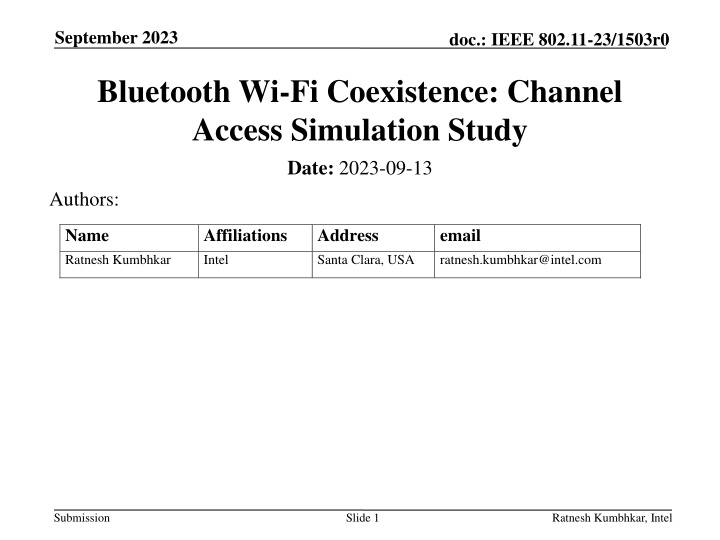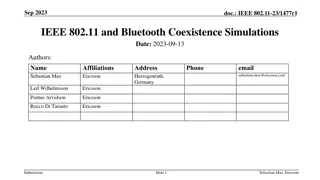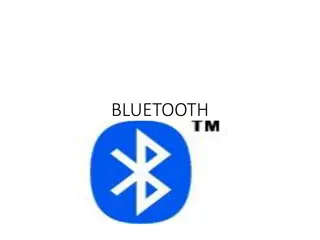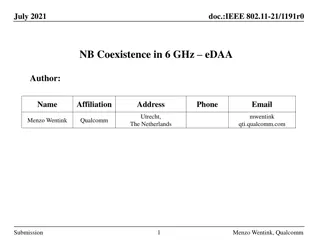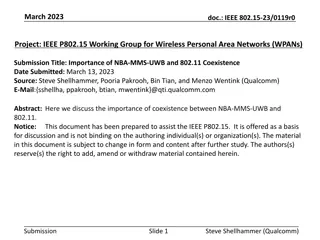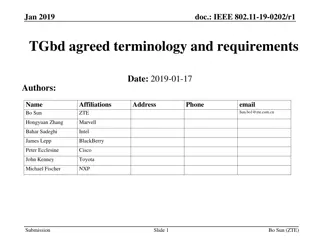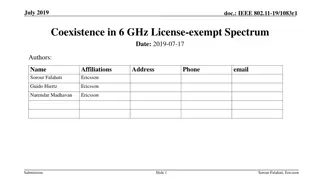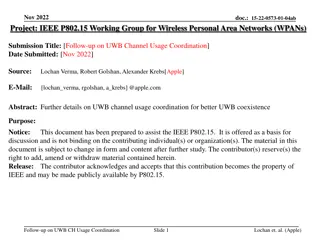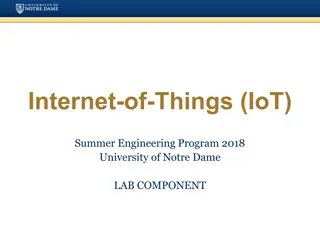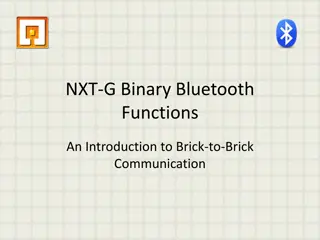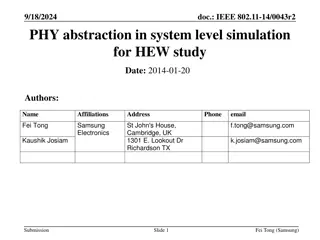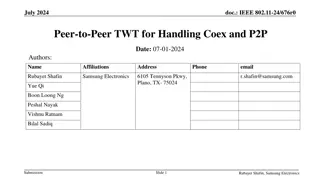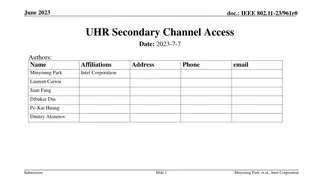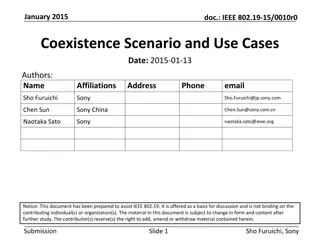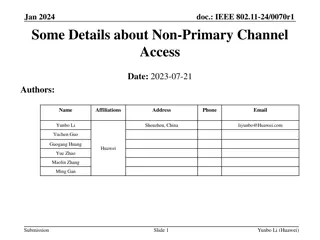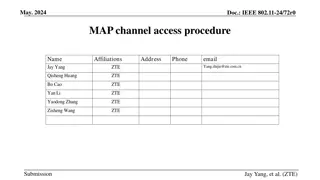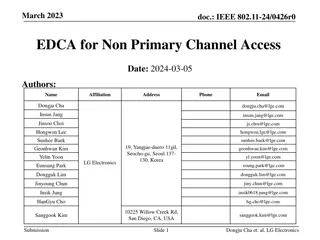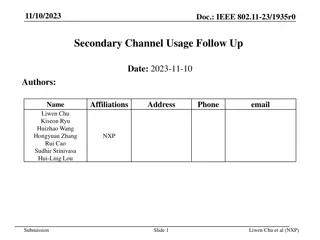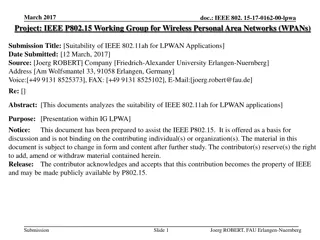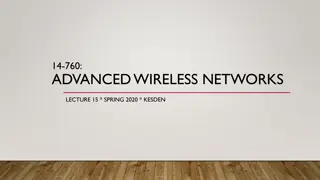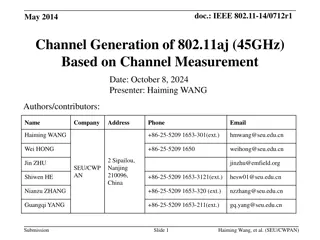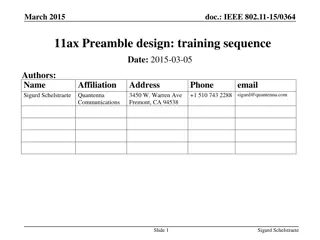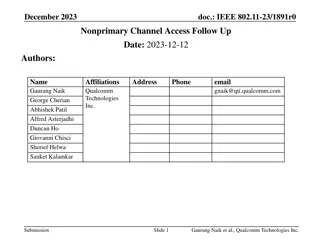Channel Access Simulation Study for Bluetooth-Wi-Fi Coexistence in IEEE 802.11-23
A detailed simulation study was conducted to analyze the coexistence of Bluetooth and Wi-Fi in the IEEE 802.11-23 standard. The study covered aspects such as channel access, transmission setup, Bluetooth-Wi-Fi interactions, impact on latency, throughput, and observations on performance under various scenarios like spectrum overlap and duty cycles. Key findings included insights on latency impact, channel interference, and throughput variations between the two technologies.
Uploaded on Sep 22, 2024 | 4 Views
Download Presentation

Please find below an Image/Link to download the presentation.
The content on the website is provided AS IS for your information and personal use only. It may not be sold, licensed, or shared on other websites without obtaining consent from the author.If you encounter any issues during the download, it is possible that the publisher has removed the file from their server.
You are allowed to download the files provided on this website for personal or commercial use, subject to the condition that they are used lawfully. All files are the property of their respective owners.
The content on the website is provided AS IS for your information and personal use only. It may not be sold, licensed, or shared on other websites without obtaining consent from the author.
E N D
Presentation Transcript
September 2023 doc.: IEEE 802.11-23/1503r0 Bluetooth Wi-Fi Coexistence: Channel Access Simulation Study Date: 2023-09-13 Authors: Name Ratnesh Kumbhkar Affiliations Intel Address Santa Clara, USA email ratnesh.kumbhkar@intel.com Submission Slide 1 Ratnesh Kumbhkar, Intel
September 2023 doc.: IEEE 802.11-23/1503r0 Simulation setup Wi-Fi: Bluetooth: Low Energy (LE) 2M PHY Gaming audio: 2 earbuds 1 earbud contains mic 1 earbud has inertial measurement unit (IMU) sensor Tx power: 14 dBm ISO interval = 7.5ms Max latency = 15ms (2 ISO) Number of subevents, NSE = 2 1 main TX + 3 retry opportunities Total 4 attempts Number of channels = 80 (each channel 2MHz wide) Total hopping BW = 160MHz Bi-directional traffic 80MHz Wi-Fi 1 AP, 1STA Tx power: 20 dBm at AP/STA MCS11 Single stream One directional traffic Traffic load: Full buffer or 60% constant bit rate, or, beacon-only TXOP duration 5ms Bandwidth = 80MHz Transmission starts at time=3s Channel model: AWGN channel with a breakpoint at 5 m pathloss = 40.05 + 20log10(f/2.4) + 20log10(min(d, b)) + (d > b) * (35log10(d/b)) where f = 5.18 GHz, d = distance, b = breakpoint = 5 m Overlap Bluetooth 160MHz O int r a 5ms s s s s ntra 5 s P s s P s s tr in transmission u nt or P u nt or P onn t d iso ronous rou nt 55 ms Submission 2 Ratnesh Kumbhkar, Intel
September 2023 doc.: IEEE 802.11-23/1503r0 Wi-Fi + Multiple Bluetooth Bluetooth central Wi-Fi AP meters Bluetooth peripheral with 2 earbuds Wi-Fi STA meters Submission 3 Ratnesh Kumbhkar, Intel
September 2023 doc.: IEEE 802.11-23/1503r0 Listen-Before-Talk (LBT) with CCA trigger LBT parameters: Trigger threshold = 3 When the threshold of 3 is reached, 3 more is added to CCA-busy for additional hysteresis. Trigger count is capped at 24 The above set of parameters is referred to as 3+3/24 [1] Submission 4 Ratnesh Kumbhkar, Intel
September 2023 doc.: IEEE 802.11-23/1503r0 LBT with CCA trigger i i Full buffer Wi-Fi O r a Observations Considerably adverse impact on Bluetooth latency with 50% spectrum overlap. Higher overlap would further degrade the performance Wi-Fi transmission is not impacted, as Bluetooth defers the transmission in Wi-Fi occupied channels Some packets did not get transmitted at all resulting in glitches Bluetooth Significant impact on Bluetooth latency Bluetooth transmissions start with ~0.1s offset Wi-Fi latency is low Wi-Fi throughput is not impacted Wi-Fi Wi-Fi starts at ~3s Submission 5 Ratnesh Kumbhkar, Intel
September 2023 doc.: IEEE 802.11-23/1503r0 LBT with CCA trigger i i Wi-Fi : 60% duty-cycle, constant bit rate O r a Observations: With low-duty-cycle Wi-Fi, Bluetooth cannot always detect, and block Wi-Fi occupied channels CCA-busy count keeps oscillating due to gaps in Wi-Fi transmission Bluetooth keeps capturing channels during gaps in Wi-Fi transmission, resulting in higher latency for Wi-Fi Still resulting in some glitches Bluetooth Wi-Fi Continuous impact on Wi-Fi throughput Increased Wi-Fi latency Submission 6 Ratnesh Kumbhkar, Intel
September 2023 doc.: IEEE 802.11-23/1503r0 Enhanced Detect and Avoid (eDAA) eDAA parameters: A separate 20MHz wideband scanner is used for signal detection 4 sweeps of Bluetooth hopping BW (in this case 160MHz) in 500ms Vacate a 20MHz band as soon as the band is found busy i i O r a Submission 7 Ratnesh Kumbhkar, Intel
September 2023 doc.: IEEE 802.11-23/1503r0 eDAA i i Full buffer Wi-Fi O r a Observations All Bluetooth links can detect and vacate Wi-Fi occupied channels Wi-Fi throughput is good Bluetooth latency is not impacted Bluetooth Bluetooth performance is good Wi-Fi throughput is not significantly impacted Wi-Fi Submission 8 Ratnesh Kumbhkar, Intel
September 2023 doc.: IEEE 802.11-23/1503r0 eDAA i i Wi-Fi : 60% duty-cycle, constant bit rate O r a Observations Frequent channel restoration caused by unreliable Wi-Fi signal detection in low-duty cycle Wi-Fi scenarios Bluetooth Results in collision with Wi-Fi and increase in the size of contention window Continuous interference from multiple Bluetooth links is detrimental for Wi-Fi Bluetooth performance is good Wi-Fi Continuous interference to Wi-Fi Significant increase in Wi-Fi latency Frequent channel restoration Submission 9 Ratnesh Kumbhkar, Intel
September 2023 doc.: IEEE 802.11-23/1503r0 eDAA: An example with modified restoration procedure Wi-Fi : 60% duty-cycle, constant bit rate i i O r a Restoration of a 20MHz band is based on last 10 sweeps This example is one of the potential solutions for a more reliable restoration procedure Bluetooth Observation: the restoration needs to be more rigorous than what is currently proposed in eDAA. Bluetooth performance is good Wi-Fi Wi-Fi throughput is not significantly impacted Submission 10 Ratnesh Kumbhkar, Intel
September 2023 doc.: IEEE 802.11-23/1503r0 Coexistence with Wi-Fi beacon-only traffic Wi-Fi AP Wi-Fi beacons have very low duty cycle with ~100ms period in primary channel. Parameters Wi-Fi beacon-only traffic (300 us, 20 MHz wide) with 102.4ms period Bluetooth traffic same as previous slides Wi-Fi STA 20MHz eDAA LBT with CCA trigger Wi-Fi Overlap % of beacons received 91.5% 99% Bluetooth 160MHz While eDAA results in higher number of collisions with beacons, there were no occurrences where two or more consecutive beacons were not received by the Wi-Fi (non-AP) STA. Submission Slide 11 Ratnesh Kumbhkar, Intel
September 2023 doc.: IEEE 802.11-23/1503r0 Observations LBT with CCA trigger Unable to meet the Bluetooth latency requirement in the case of 50% spectrum overlap. With growing overlap, the latency will likely become worse. Still seen with newly suggested LBT 3+3/24 While the performance for full-buffer Wi-Fi is good, Wi-Fi latency is impacted for low duty-cycle Wi-Fi No impact on beacon-only transmission eDAA Better for Bluetooth performance Significant throughput impact on Wi-Fi specifically when detection is not reliable e.g., low duty-cycle Wi-Fi Coexistence with Wi-Fi can be improved by a more robust restoration procedure. This results in better Wi-Fi throughput and latency. Slightly higher impact on beacon-only transmission, but may not be significant enough causing loss of connection Submission 12 Ratnesh Kumbhkar, Intel
September 2023 doc.: IEEE 802.11-23/1503r0 Next steps Agreement on realistic simulation scenarios Wi-Fi traffic load: Low duty cycle (5-10%), medium duty cycle (50-60%) and full buffer Bluetooth low energy traffic pattern: Based on realistic cases such as gaming audio Network topologies: Capturing mutual impact Agreement on performance metrics for Bluetooth and Wi-Fi Throughput Latency Detection accuracy and speed Energy efficiency Others Rethink Frequency hopping kernel Impact of the latency associated with channel map update Submission Slide 13 Ratnesh Kumbhkar, Intel
September 2023 doc.: IEEE 802.11-23/1503r0 References [1] Bluetooth SIG bt_sig_nb_with_lbt_qualcomm_september_2023_budapest_r1 [2] IEEE 11-23-1279-coex-00, IEEE Berlin, July 2023 [3] BRAN(21)109h004r2_EN_303_687_NB_Proposals_for_DAA_Optimisation [4] BRAN(21)109h007_NB_coexistence_with_WB_in_6_GHz Submission Slide 14 Ratnesh Kumbhkar, Intel
